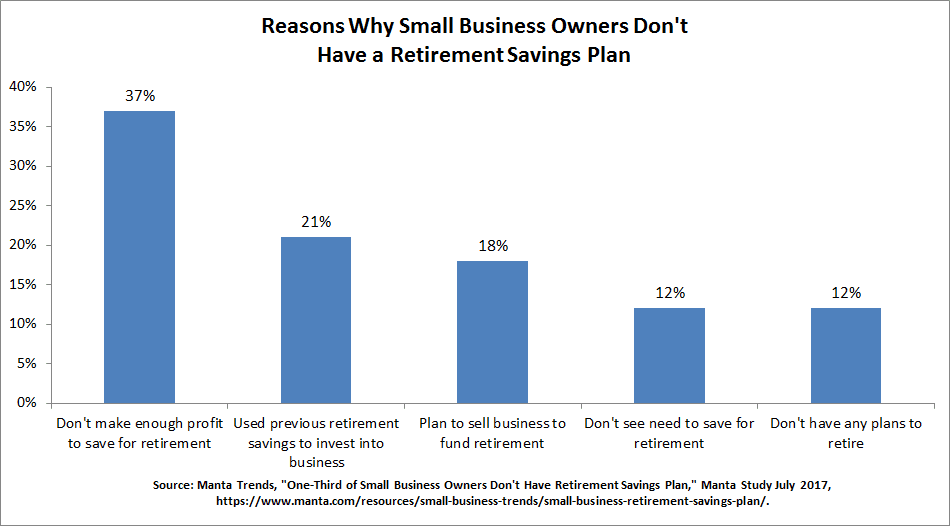Retirement Income Planning Tips for Small Business Owners

Retirement income planning already is difficult. But for small business owners, it poses even more challenges. Despite being used to the hustle-and-bustle of day-to-day tasks and operations, even businesspersons have to slow down at some point.
Eventually entrepreneurs get to an age when they can’t run their companies like they did before. As a company owner, you likely will face this someday. You may have to reduce your involvement, or it may even be time for an exit. If that’s in the cards, you might have to sell your business or let someone else in the family take it over.
In any case, there’s retirement at the end, and moving into retirement means you have to make plans to safeguard your financial future. In practice, this means being able to pay the bills today while saving enough to live off tomorrow (when your business can be no longer a source of personal income for you – or less income).
Retirement income planning, however, is not a linear thing. It entails holistically evaluating your lifestyle alongside your income and making projections for your life after retirement; then putting in place protections to ensure you can enjoy a lifestyle that’s right for you as long as you live.
If you are confused about what you should do to retire happy and comfortably, you are not the only one. Many small business owners – not to mention several Americans in general – are in the same boat as you. Read on for some helpful tips to assist you with enjoying more lifelong retirement income certainty.
What Retirement Planning Issues Do Business Owners Face?
First things first, what potential retirement roadblocks might small business entreprenurs encounter? Just like other investors, small business owners have their own retirement challenges. A big issue relates to instruments for accumulating wealth. According to a recent survey by Manta, over one-third (34%) of small business owners have no retirement savings plan.
When asked why, small business entrepreneurs gave a host of reasons, including:
- “I don’t make enough profits to save for retirement”
- “I used my previous retirement savings to invest into my business”
- “I plan to sell my business to fund my retirement”
- “I don’t see the need to save for retirement”
- “I don’t have any plans to retire”

Other surveys echo these findings. A study by BMO Wealth Management found that 75% of small business owners, aged 18-64, have less than $100,000 saved for retirement. 8% reported they had over $500,000. Among those aged 45-64, just 32% had more than $100,000 in retirement accounts, and a mere 11% had over $500,000 saved up. These trends could be troublesome as small business owners turn to their assets and savings for income streams.
First Things First: Retirement Readiness and What It Should Entail
Sure, accumulating assets and building up savings is an important part of retirement planning. But retirement is a period of decumulation, or drawing down assets and savings for income. So, it’s even more critical to have a blueprint for ensuring this money lasts for a retirement lifetime.
If your finances are to be truly “retirement-ready,” they must take into account today’s extended lifespan. People are living longer than before. The graph below illustrates how U.S. life expectancy from age 65 has risen over time. And while a longer lifespan is a good thing, it has the undesirable implication of making certain risks even more prevalent.
As longevity, or the possibility of spending many years in retirement, increases, these risks multiply:
- Inflation eroding your purchasing power
- Market corrections arising and affecting economic conditions
- The possibility of you withdrawing too much money
- Costly health and care needs arising
- Changing economic landscape affecting your company
Once your business involvement changes, you may be looking at an extended timespan in retirement. As such, if you were to live off a fixed lump sum, the demand for it will be significantly stretched out. Yet in time, factors such as inflation and recurrent health needs put a strain on your stockpile of retirement funds. In turn, that increases your chances of running out of money.
Small Businesses are at a Bigger Risk
These concerns tend to throw small business owners into a retirement crisis – largely because for most of them, the business is apparently their retirement plan. In a 2015 survey by the Financial Planning Association and CNBC, 78% of small business owners indicated selling their companies was their vehicle for funding retirement. They also said their company sales would need to account for as much as 60%-100% of their retirement needs!
In the same token, CNBC and FPA also found that 70% of small business owners’ wealth was invested in their companies! Just 30% was invested outside their firms. Think about it. From a risk standpoint, what would happen if something unexpected arose in your business? How would it affect your retirement and income goals, especially if your company was going to be your vehicle for generating income?
Whether you intend to transfer the business to a family member and live off yields, or you intend to sell the company and turn it into cash, this can be a dangerous choice — no matter whichever way you look at it. For one, the economy can sometimes become fragile and the odds may not always work in your favor. You wouldn’t want to experience the consequences if the business should fail.
Second, there are risks for the entrepreneur who is building all hopes on selling their business for cash. This hinges on the uncertainty of finding the right business buyer at the right price. But with as many 10 million baby boomers lining up to sell their companies, a “hassle-free” business exit is anything but certain. And again, longevity risk is at play. What would happen if you outlived the amount you obtained from the sales proceeds?
Point is, these approaches mean an overreliance on your business for retirement goals — which is putting your eggs into one basket. That’s a dangerous move any day. What to do?
Diversify and Manage Risk
So, start to build a strong financial foundation by creating a suitable risk diversification strategy today. The timeline for doing this is even important if you are 10 years or less out from your intended retirement date. Your retirement plan should clearly spell out personal money goals, separate from the money goals you have for your business.
Should you be in the “retirement red zone,” or that 10-year timeline mentioned earlier, now is a great time to start planning for your future income goals. Ideally, you will determine your life expectations, look at your current expense and income patterns, and project your future annual expenses. From monthly costs of living to discretionary spending on luxury goods, entertainment, and other non-essentials, your annual spending proections should go over a 25-to-30-year basis or longer. Make sure to account for inflation each year in those projections.
Then build a nest egg and retirement plan that will provide you with the financial resources you need for that duration. Along with strategies to catch up on savings and accumulate money for your goals, if needed, you will want to consider ways to preserve existing wealth and ready it for when you start needing retirement income.
Tips for More Income Certainty and Financial Safety
As you plan for your retirement future, here are some additional retirement and income planning insights to consider:
1. Understand tax deferral and take advantage of it. When your personal and business money goals are separated, it makes sense to capitalize on tax-advantaged retirement accounts to maximize your wealth. Retirement savings plans such as self-employed 401(k)s, traditional and Roth IRAs, plus SIMPLE and SEP IRAs offer the benefit of letting your money multiply tax-deferred. It doesn’t mean small business owners have to throw huge sums of money into these plans. But the potential for tax-sheltered growth adds up, until you start taking withdrawals in retirement.
You may already be maximizing contributions to those accounts. An option for starting to preserve your wealth, while enjoying some potential for safe money growth, might be in an annuity contract. Annuities don’t come with contribution limits by the IRS. And they also let your money grow tax-deferred until you start drawing income from them. For that matter, from a retirement planning standpoint, they provide a useful function for protection and risk management.
Annuities are also the only financial product that can provide an income stream backed by contractual guarantees. For a retirement plan, deferred annuities, or contracts designed to help your money grow over time, might be worth consideration. They can be a powerful strategy for “parking” additional monies and, in retirement, covering your monthly fixed-income needs with a reliable income stream.
2. Prepare for the contingencies. Some common income planning mistakes are neglecting later-stage costs in retirement — health costs and potentially long-term care expenses. Fidelity Investments estimates that a 65-year-old couple retiring in 2023 could pay $315,000 in retirement healthcare and medical expenses. That is without healthcare expenses added in.
Long-term care can be expensive in its own right. The Centers for Medicare and Medicaid Services project over 45% of people aged 65+ will spend time in a nursing home. Nursing home costs can be $48,000-$60,000 or even more per year. And if in-home care services are needed, a home health nurse or aide can cost $100 per day.
So, start planning for these contingencies now. You will want to have a plan if you have to retire earlier than expected, especially for reasons relating to physical condition. Over half of retired Americans departed from the workforce earlier than they anticipated due to factors such as disability, according to the Employee Benefits Research Institute. Disability insurance can serve as a soure of financial protection. As for covering expenses like medical or personal care services, some life insurance products come with “living benefit riders,” or features which let you draw on your policy death benefit or cash value for care expenses.
3. If you do have wealth invested in external assets, evaluate your diversification strategy. Remember, retirement is not a period of continuing to focus on accumulating assets and building up savings, but rather receiving income! Distributions from various income sources is also far different from putting away money so it multiplies with investment growth.
As you get closer to your retirement years, ask yourself: Is your current portfolio diversification strategy right for your age, needs, and looming retirement goals? Is it steadily taking a lower amount of exposure to market risk? Does it have protections in place against the retirement risks we covered earlier? If you have a very low tolerance for risk, do strategies for preserving and protecting your wealth make sense for your financial picture?
You shouldn’t go at these questions alone. Working with a knowledgeable financial professional can help you find the answers you need. Here at SafeMoney.com, many featured financial and insurance professionals stand ready to help you with your income and retirement financial goals.
Wrapping It Up
While many small business owners tend to approach retirement planning as being about accumulating assets and growing investments, that approach is simplistic. Retirement cuts across your lifestyle, income and management of risks. As you prepare for your retirement therefore, it is important that you recognize retirement income planning as broad. Most importantly, it is best to have an advocate in your corner to guide you and keep looking out for you.
When you are ready for personal guidance, a financial professional here at SafeMoney.com can assist you. Use our Find a Financial Professional section to connect directly with a financial professional locally for your retirement and income planning goals. And if you need a direct referral, you can reach us at 877.476.9723.








